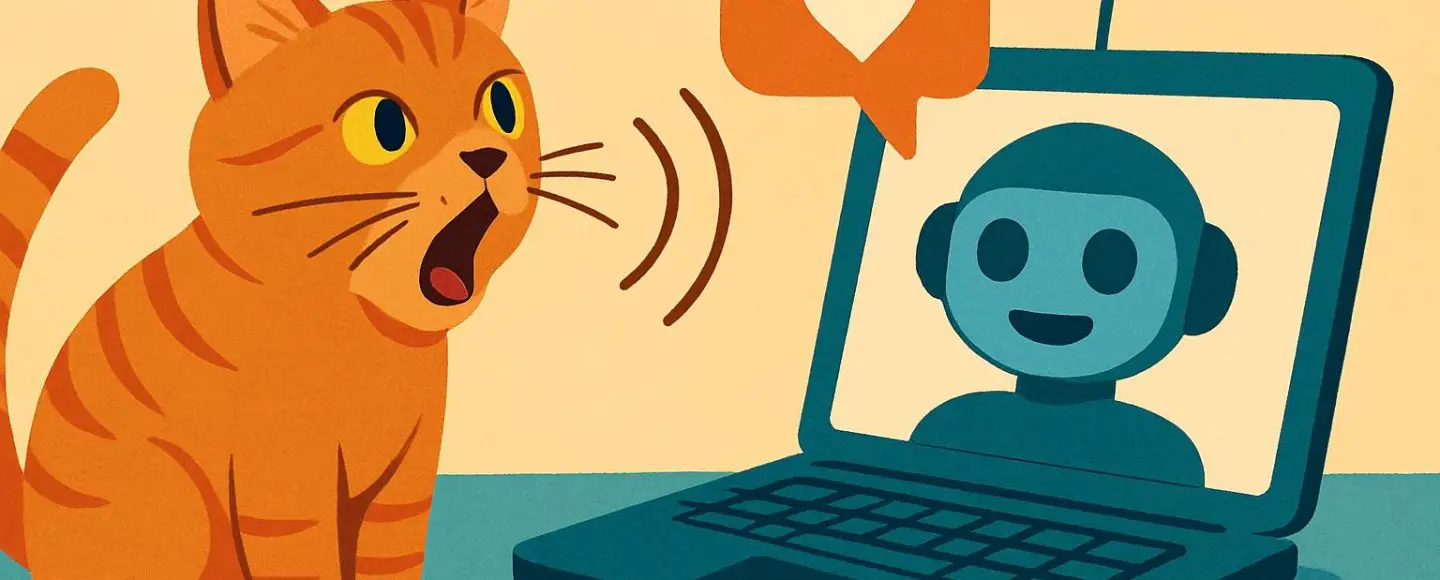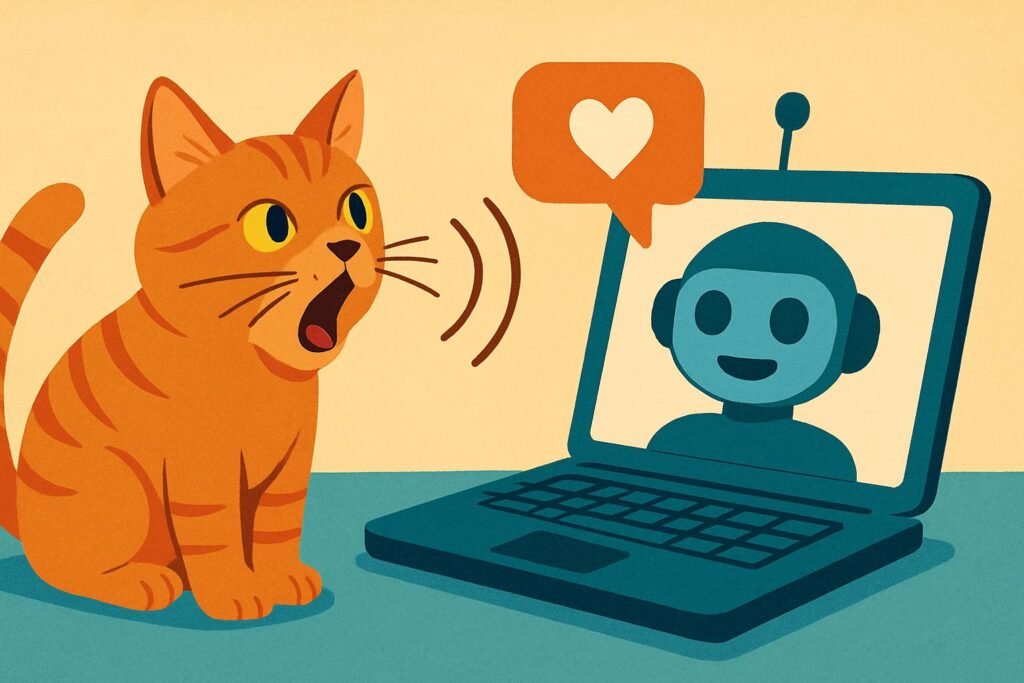
AI Translates Cat Meows
AI translation of cat meows has become a fascinating crossover between pet ownership and machine learning. Many cat owners wish they could understand the true intent behind every meow, chirp, or yowl. Tools powered by artificial intelligence, like the MeowTalk app, are being developed to classify feline sounds into emotional categories such as hunger, affection, or irritation. While progress is being made, today’s tools are still more experimental than definitive. This growing category of AI for pet communication is trying to make the connection between cats and humans more intuitive and meaningful.
Key Takeaways
- AI-powered tools like MeowTalk aim to translate cat vocalizations into human-readable interpretations of intent or emotion.
- These tools use machine learning to create customized profiles for individual cats over time.
- Current models are not yet scientifically validated but reflect broader interest in animal communication through AI.
- AI-based pet communication tools are also being developed for dogs, birds, and other animals.
Why Build AI Cat Translators?
The idea of translating cat sounds may sound playful, although there are serious motivations. Cats are highly vocal, especially when they interact with humans. Each vocal sound may signal a distinct feeling or need, whether that’s a call for food, a sign of discomfort, or an expression of curiosity. Understanding these sounds better can improve the way humans relate to their feline companions.
Cats do not communicate using one shared language. Instead, each cat often develops its own combination of meows, chirps, and squeaks. These variations depend on context, tone, and frequency. This individuality makes it difficult to generalize. That is where AI steps in with its adaptive ability to create custom models.
How MeowTalk Functions
The MeowTalk app, developed by Javier Sanchez, a former Amazon Alexa engineer, uses machine learning to decode and categorize meows. These categories might include phrases like “I’m hungry” or “Let me outside.” Rather than relying on a preset database, the app gradually learns from user recordings and feedback to become more accurate over time.
Here is how the translation process typically works:
- Users record a meow through the app.
- The AI processes the audio, analyzing pitch, duration, and frequency.
- It suggests a possible meaning based on its current model.
- The user accepts or edits the interpretation, refining the AI’s profile of that cat.
This method creates a personalized vocal profile for each cat. Since feline communication is unique to each animal, this individual focus helps build understanding without relying on a single global language model for all cats.
Comparing AI translators for cats and others
AI translation for cats fits within a larger push to use artificial intelligence for animal interaction. Similar tools appear in other species too:
- Dogs: Silent Talker AI helps assess emotions or physical needs of working dogs by reading their body posture and vocal signals.
- Birds: Some AI models look at how parrots use mimicked words in context, combining language processing and behavioral cues.
- Livestock: Farmers are now using AI-based systems to detect signs of stress or illness in animals, often before symptoms appear externally.
This use of AI to interpret behavior is expanding quickly. For more insights into the intersection of technology and animal behavior, you can explore how animals interact with AI robots.
Limitations in Accuracy and Scientific Proof
Although apps like MeowTalk generate interest, they are not yet grounded in peer-reviewed science. Most rely on crowdsourced or user-driven data. That means their predictions are guided by user feedback rather than scientific behavioral studies.
Some researchers caution that giving emotional meanings to meows may result in anthropomorphism, which refers to assigning human emotions to animals without proof. While the effort to understand animals better is valuable, it is most effective when combined with physical cues and professional veterinary care.
MeowTalk currently serves more as a diary that helps track vocal trends. When a translation lines up with an event or behavior, users see it as accurate, although the interpretation remains speculative without scientific backing. Projects that pair app development with university-driven studies could raise the bar. Tools described in studies such as how AI decodes pet emotions hint at where the field may head with more rigorous support.
Ethics, Privacy, and Data Concerns
With all AI tools, data management is key. Cat translation apps require users to record sounds within the home environment. These recordings are often uploaded to remote servers for analysis. Yet many users are unaware of how that data is stored or managed.
Some sounds captured may include background conversations or environmental noise. Developers claim such data is anonymized and not used beyond training, but transparency is limited. Clear guidelines are needed from app creators, especially for apps collecting data from within private living spaces.
There is also the concern that relying too much on AI interpretation might cause people to overlook more critical signs of pet health. Behavioral changes, eating habits, or physical distress often provide more reliable health indicators than sound alone.
Cat translator apps have entertaining appeal right now, although their future could involve more serious uses. For instance, veterinarians may someday monitor vocal patterns using AI to track distress or discomfort. Animal shelters might use translation tools to assess stress or fear in newly rescued cats that are still adjusting to indoor life.
Developments are already moving in that direction. Open-sourced audio libraries and partnerships with academic teams are being explored. Early trials are looking at how smart collars and home assistant devices might integrate cat communication tools. In one surprising case, an AI-powered robot trained as a teacher also interacted with animals, as described in the article about an AI robot becoming the first teacher.
As the technology matures, AI language and recording tools might be embedded into smart cameras or home monitoring systems, offering real-time alerts when a cat’s vocal behavior shifts unexpectedly.
Breakdown of Cat Translator Apps
| App Name | Platform | Key Features | User Rating | Free Version? |
|---|---|---|---|---|
| MeowTalk | iOS, Android | Custom profiles, emotional coding, saved translation records | 4.0 (Google Play) | Yes (Paid upgrade available) |
| Cat Translator Simulator | iOS, Android | Basic phrases, entertainment focus, manual input allowed | 3.8 | Yes |
| PawConvo (Beta) | Android | Contextual phrase recognition, data insights, still in trial | 3.5 (Early Access) | Yes |
FAQ: AI and Cat Communication
Can AI offer accurate translations of cat sounds?
Not precisely. AI can recognize patterns and associate them with likely messages, although its insights are still best viewed as estimates rather than definitive statements.
Is MeowTalk backed by scientific research?
MeowTalk follows machine learning methods but lacks third-party validation. Its interpretive power depends heavily on user feedback and experience.
What do a cat’s meows reflect emotionally?
Meows can indicate feelings like boredom, excitement, or hunger. Apps use general categories, while behaviors like movement, posture, and eye response can help confirm interpretations.
Can veterinarians benefit from these tools?
Potentially. If properly integrated, voice tracking over time could help veterinarians detect issues earlier or better tailor care.
Do cats have a universal language that AI can decode?
No. Cats do not have a standardized vocal language. Each cat tends to develop unique sound patterns based on its environment and interactions with humans, which limits AI’s ability to generalize across different cats.
How does AI learn to interpret cat sounds?
AI models are trained using labeled audio recordings of meows paired with human interpretations. The system looks for recurring patterns in pitch, duration, and tone, then associates them with likely meanings such as “feed me” or “let me out.”
Can AI distinguish between meows from different cats?
Some apps attempt to create personalized models for each cat. This works better than generic translations since meows are often context-dependent and vary between individuals. More training data usually improves accuracy for each specific cat.
Are these tools useful for multi-cat households?
Not always. Distinguishing between cats in real-time audio can be difficult unless each cat is recorded separately. Some apps allow user tagging of recordings to build profiles for individual pets.
Is it possible to have two-way communication with a cat using AI?
Not yet. While some apps can translate human phrases into cat-like sounds, there is no evidence that cats perceive or respond to these outputs as communication. The function is more playful than practical.
Can AI tools detect pain or illness in cat vocalizations?
Some researchers are exploring this, but current commercial apps are not medically validated. Subtle changes in meow patterns might one day help detect discomfort, though veterinary examination remains essential for diagnosis.
What data privacy concerns exist with pet communication apps?
These apps may store audio, location, and behavioral data. Users should check privacy policies, especially if data is shared with third parties or used for commercial training purposes.
How are AI-generated insights different from animal behaviorist evaluations?
AI offers data-driven estimates based on vocal patterns. Animal behaviorists assess context, body language, and environmental factors to provide more holistic insights. The two approaches can complement one another but should not be seen as interchangeable.
Will AI tools for animals improve over time?
Yes. As more recordings are collected and labeled, machine learning models will refine their ability to detect subtleties. Integration with video, wearables, or environmental sensors may also enhance accuracy.
Conclusion
AI tools like MeowTalk represent a novel effort to bridge the communication gap between humans and cats, offering playful interpretations and potential insights into feline behavior. While current capabilities remain limited and largely unverified, ongoing data collection and model refinement could improve accuracy over time. These tools are not substitutes for veterinary care or expert observation, but they open new possibilities for understanding pets through technology. As AI evolves, it may deepen the way we interpret animal behavior, fostering closer bonds between humans and their companion animals.
References
Brynjolfsson, Erik, and Andrew McAfee. The Second Machine Age: Work, Progress, and Prosperity in a Time of Brilliant Technologies. W. W. Norton & Company, 2016.
Marcus, Gary, and Ernest Davis. Rebooting AI: Building Artificial Intelligence We Can Trust. Vintage, 2019.
Russell, Stuart. Human Compatible: Artificial Intelligence and the Problem of Control. Viking, 2019.
Webb, Amy. The Big Nine: How the Tech Titans and Their Thinking Machines Could Warp Humanity. PublicAffairs, 2019.
Crevier, Daniel. AI: The Tumultuous History of the Search for Artificial Intelligence. Basic Books, 1993.


